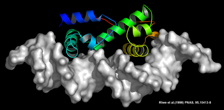Regulatory Mechanisms that govern expression of Type III
Secretion systems in gram-negative bacterial pathogens
In their quest for survival, microbial pathogens have evolved
elaborate mechanisms to invade and exploit their mammalian
hosts. In many gram-negative bacterial bacteria type III
secretion systems are main stays of virulence. These
syringe-like molecular machines are employed to transport
arsenals of virulence factor directly into the cytoplasm of a
eukaryotic host cells. Inside the host, the toxins act to
suppress and evade the innate host immune response, prepare the
host for invasion, and induce apoptosis. Some of the most potent
pathogens utilize type III secretion systems: Yersinia pestis,
enteropathogenic E.coli, Shigella flexneri, Salmonella enterica.,
and Pseudomonas aeruginosa to name a few. Since disruption of
the type III secretion apparatus invariably leads to a
significant attenuation of virulence, the structural and
functional components of the secretion machinery are considered
high value drug targets. Rather than targeting individual components of secretion
machinery we have decided to focus our efforts on achieving a
broader impact by suppressing the regulatory cascades that
activate expression of multiple type III secretion-related
genes.

Structural Biology of Inc Proteins in Chlamydiae pneumoniae and
Chlamydiae trachomatis
Chlamydiae species are causative agents for a large variety of
diseases. Host cell invasion is one of the survival strategies
the microbes employ to escape detection by the host immune
system. After invasion bacteria are maintained within unique
vacuoles also called inclusions. Inclusion membrane proteins or
Inc proteins have been implicated as critical mediators for
inclusion formation and maintenance process. Inc proteins seem
to be unique to the Chlamydiae species and share little sequence
homology beyond a characteristic large bilobed hydrophobic
region of 40–70 amino acids. Remarkably, these proteins are
translocated into mammalian cells via a type III secretion
apparatus. Inside the host Inc proteins are inserted into the
inclusion membrane from where they interact with a variety of
host factors to facilitate invasion (for a review please see:
Rockey, D.D. et al. (2002) Microbes and Infection, 4, 333–340).
There is limited functional and no structural information
available for Inc proteins. We will initiate structural studies
on a representative subset of these proteins. The structural
data, in addition to potentially providing functional insights,
will form the foundation for a structure-based search for potent
inhibitors that leads to the disruption of the inclusion, thus
allowing more efficient clearance of an infection. Our efforts
will be coordinated with work on the biology of Inc proteins
ongoing in several laboratories at the University of Miami
Medical School.